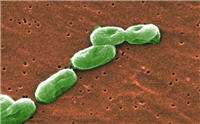Burkholderia cepacia in Healthcare Settings
General Information about B. cepacia
Burkholderia cepacia [burk–hōld–er–uh si–pay–shee–uh] (also called B. cepacia) is the name for a group or “complex” of bacteria that can be found in soil and water. B. cepacia bacteria are often resistant to common antibiotics.
Populations susceptible to B. cepacia infection
B. cepacia poses little medical risk to healthy people. However, people who have certain health problems like weakened immune systems or chronic lung diseases, particularly cystic fibrosis, may be more susceptible to infections with B. cepacia. B cepacia is a known cause of infections in hospitalized patients.
Symptoms of B. cepacia infection
The effects of B. cepacia on people vary widely, ranging from no symptoms at all to serious respiratory infections, especially in patients with cystic fibrosis.

For more images of this bacterium, search the Public Health Image Library
Transmission of B. cepacia infection
Transmission of B. cepacia from contaminated medicines and devices has been reported.
In 2005, CDC was notified by several states of clusters of pneumonia and other infections caused by B. cepacia and associated with contaminated mouthwash.
In 2004, CDC was notified of a voluntary recall of over-the-counter nasal spray due to contamination with B. cepacia complex. For more information see the MMWR article.
Also in 2004, B. cepacia was linked to nosocomial infections among intensive care unit patients and associated with exposure to sublingual probes. For more information see the MMWR article.
B. cepacia can also be spread to susceptible persons by:
- Person-to-person contact
- Contact with contaminated surfaces
- Exposure to B. cepacia in the environment.
Treatment of B. cepacia infection
B. cepacia can be resistant to many common antibiotics. Decisions on the treatment of infections with B. cepacia should be made on a case-by-case basis.
Recommendations and Guidelines
Careful attention to infection control procedures like hand hygiene can help reduce the risk of transmission of this organism. For more information on hand hygiene and infection control practices see:
- Rutala WA, Weber DJ, the Healthcare Infection Control Practices Advisory Committee (HICPAC). Guideline for Disinfection and Sterilization in Healthcare Facilities, 2008
- Siegel JD, Rhinehart E, Jackson M, et al. the Healthcare Infection Control Practices Advisory Committee (HICPAC). Guideline for Isolation Precautions: Preventing Transmission of Infectious Agents in Healthcare Settings, 2007
- Siegel JD, Rhinehart E, Jackson M, et al. The Healthcare Infection Control Practices Advisory Committee (HICPAC). Management of Multidrug-Resistant Organisms In Healthcare Settings, 2006
- Guideline for Environmental Infection Control in Health-Care Facilities, 2003 [PDF - 1.4 MB]
- CDC. Boyce JM, Pittet D. the Healthcare Infection Control Practices Advisory Committee (HICPAC). Guidelines for Hand Hygiene in Healthcare Settings, 2002
Guideline, Fact sheet and special materials to promote Hand Hygiene in healthcare facilities
Get email updates
To receive email updates about this page, enter your email address:
Contact Us:
- Centers for Disease Control and Prevention
1600 Clifton Rd
Atlanta, GA 30333 - 800-CDC-INFO
(800-232-4636)
TTY: (888) 232-6348 - New Hours of Operation
8am-8pm ET/Monday-Friday
Closed Holidays - cdcinfo@cdc.gov


